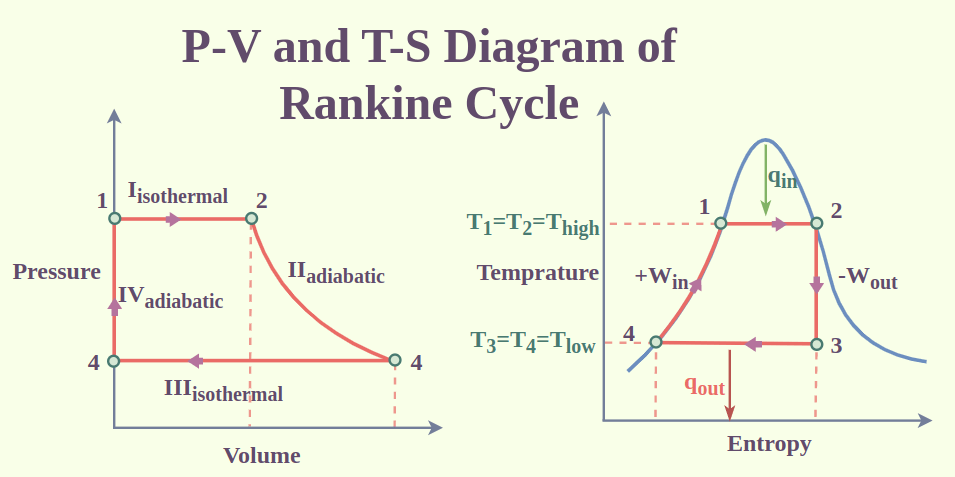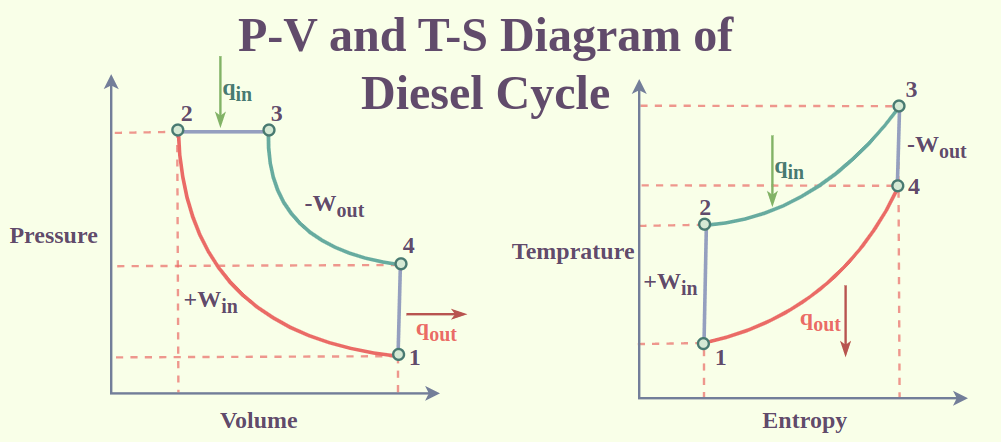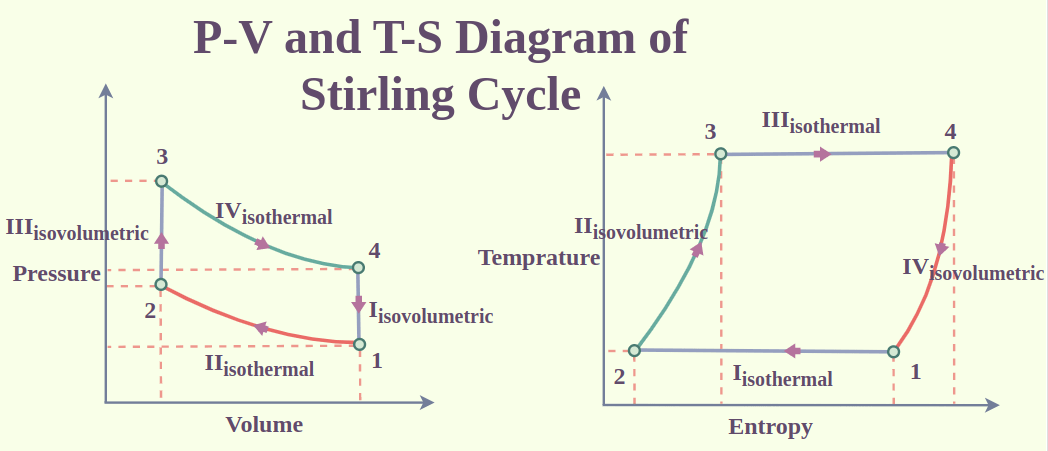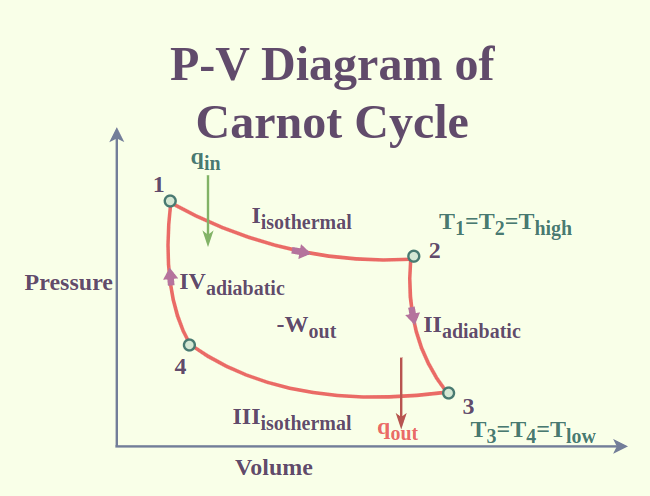
|
|
Thermodynamic cycles are used to explain how heat engines, which convert heat into work, operate. A thermodynamic cycle is used to accomplish this. The application determines the kind of cycle that is employed in the engine. The thermodynamic cycle consists of a series of interrelated thermodynamic processes involving heat and works going in and out of the body, simultaneously changing pressure, temperature, and other changes in body state, and eventually returning to the initial state. In this article, we will learn all about the Thermodynamics Cycles including various types of cycles such as Carnot, Rankin, Otto, Diesel, Brayton, Stirling, etc. Also, we will learn about the various processes happening during these cycles. So, let’s start our learning of Thermodynamics Cycles. What is Thermodynamics Cycle?A thermodynamic cycle is a series of thermodynamic actions that, when carried out repeatedly, leave the system in the same state as when it was first created. Thermodynamic cycles are used to explain how heat engines, which convert heat into work, operate. The thermodynamic cycle is a closed cycle that has many changes due to temperature, pressure, and volume, but whose end and initial states are equal. This cycle is important because it allows the piston in the engine to move continuously and the fluid working in the refrigerator to expand/compress. Without this cycle, the vehicle will not be able to continue running or the refrigerator will not be able to cool when restarted. Types of Thermodynamic CyclesThere are various types of cycles in thermodynamics, and some of those important cycles are listed as follows:
Now, let’s understand these cycles in detail. Carnot CycleThe French physicist Sadi Carnot proposed the imagined Carnot cycle in 1824. It is a thermodynamic cycle. Transforming heat into work or work into heat, is the most effective cycle that is currently known to exist. The Carnot cycle consists of four processes that can be reversed:
The Carnot cycle can be addressed on a temperature-entropy graph as a closed circle. The proficiency of the Carnot cycle is determined by the situation.
The Carnot cycle is an optimal cycle, and no genuine motor can accomplish its effectiveness. In any case, the Carnot cycle is a valuable hypothetical model that can be utilized to look at the proficiency of various motors. The Carnot cycle is likewise significant in the field of refrigeration. A fridge works by retaining heat from a cold space and delivering it to a hot space. The Carnot cycle can be utilized to determine the greatest effectiveness of a cooler. Here is a diagram of the Carnot cycle: 
The four processes are labeled as 1-2, 2-3, 3-4, and 4-1. The arrows indicate the direction of heat flow and work done. An essential idea in thermodynamics is the Carnot cycle. As a helpful theoretical model for comprehending these appliances, it sets a maximum efficiency limit for heat engines and refrigerators. Learn more about Carnot Engine Rankine CycleA steam turbine’s method of converting heat into mechanical work is described by the Rankine cycle, a thermodynamic cycle. The cycle is named after Scottish engineer William John Macquorn Rankine, who created it in the middle of the 19th century. The Rankine cycle has four steps, which are as follows:
The fundamental thermodynamic cycle used in all steam power plants is the Rankine cycle. Other applications, such as solar thermal power plants and geothermal power plants, also make use of it.
The Rankine cycle is a thermodynamically reversible cycle, which means that all of the heat input may be converted back into labour. Friction, heat transmission, and other variables cause losses in practice nevertheless. As a result, the Rankine cycle’s efficiency is normally between 30 and 40%. The Rankine cycle is available in a variety of forms, including the supercritical, reheat, and regenerative cycles. Through a reduction in the quantity of heat rejected by the environment, these modifications aim to increase the cycle’s efficiency. Otto CycleNikolaus August Otto, who patented the first four-stroke internal combustion engine in 1876, is the inspiration for the Otto cycle. Many modern internal combustion engines still use the Otto cycle, however other cycles, such as the Atkinson cycle, are still used in some applications. The Otto cycle is a simplified thermodynamic cycle that depicts how a common spark ignition piston engine works. It is the Highest frequent thermodynamic cycle seen in car engines. The Otto cycle is made up of four processes:
The Otto cycle is an imagined cycle, although actual engines do not follow it exactly. The Otto cycle, on the other hand, is a valuable model for understanding how spark ignition engines work. 
The compression ratio, which is the ratio of the volume of the cylinder at the end of the intake stroke to the volume of the cylinder at the conclusion of the compression stroke, determines the Otto cycle’s efficiency. The cycle is more effective with a higher compression ratio. Diesel CycleThe operation of a diesel engine is described by the Diesel cycle, a thermodynamic cycle. It has a four-stroke cycle, which means that one cycle of operation requires the piston in the engine to make four strokes. There are four strokes:
Compared to the Otto cycle, which is utilized in petrol engines, the Diesel cycle is more effective. This is so that the gasoline may ignite more readily and completely. A diesel engine’s increased compression ratio raises the temperature at the end of the compression stroke. Diesel engines are therefore more efficient than petrol engines. Additionally, the Diesel cycle is stronger than the Otto cycle. This is due to the fact that a spark plug is not used to ignite the fuel in a diesel engine, thus there is no chance of a misfire if the spark plug breaks. As a result, diesel engines are frequently utilized in settings where dependability is crucial, such as heavy-duty vehicles and buses. Here is a P-V and T-S diagram of the Diesel cycle:
The Diesel cycle’s four strokes are identified by the numbers 1-2-3-4. The direction of the piston movement is shown by the arrows. The lines’ colors represent several thermodynamic processes:
Brayton CycleOne type of heat engine that uses air or another gas as its working fluid operates according to a thermodynamic cycle called the Brayton cycle. Modern gas turbine engines and air-breathing jet engines also follow the Brayton cycle; however, the original Brayton engine had a piston compressor and piston expander. The Carnot efficiency, which is determined by the following equation, is what determines the Brayton cycle’s efficiency:
Here are some more specifics on the four steps of the Brayton cycle:
Heat may be converted into work very effectively using the Brayton cycle. However, the heated reservoir’s temperature has a limit on the cycle’s efficiency. In reality, the materials used to build the engine have a limit on how hot the hot reservoir can go. 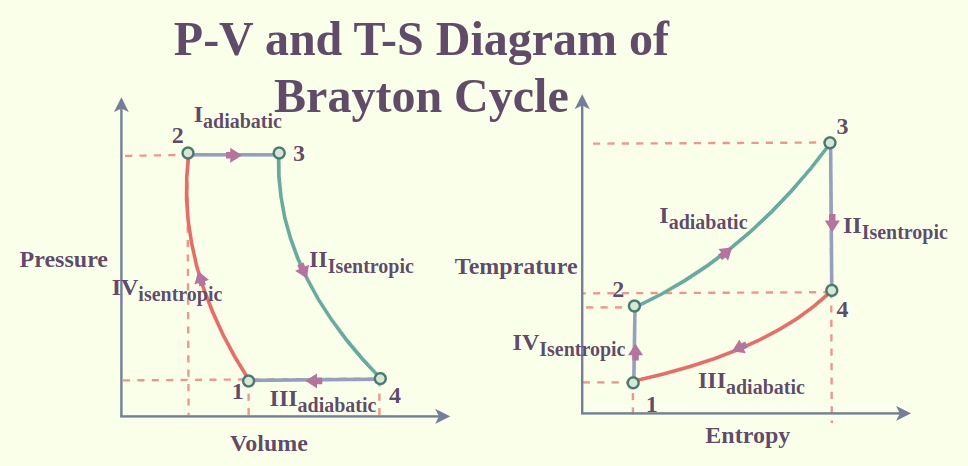
There are numerous applications for the Brayton cycle, including:
Stirling CycleThe operation of a Stirling engine, a particular kind of heat engine, is described by the Stirling cycle, a thermodynamic cycle. It bears the name of Scottish cleric Robert Stirling, who developed the engine in 1816. Because of its great efficiency and versatility in heat sources, the Stirling engine is popular for use in applications like electricity production, heating, and cooling. The Stirling cycle consists of four main processes:
After heat rejection, the working fluid goes back to the compression space to start the cycle over. The Stirling cycle is a closed-loop process, which means the working fluid stays inside the engine and goes through the same cycle repeatedly. Processes in Thermodynamic CyclesThere are various processes in each Thermodynamic Cycle, some of these processes are: Heat Addition and RejectionThe working fluid enters a regenerator, a heat exchanger that stores and releases thermal energy, after compression. The working fluid is in contact with a high-temperature heat source during a constant volume heat addition procedure after that. As a result, the temperature and pressure rise and the expansion continues. The working fluid then enters a constant volume heat rejection procedure on the cold side of the engine. A low-temperature heat sink, like air or water, contracts and loses pressure when heat is released into it. Compression and ExpansionThe cycle starts with an isothermal compression process, in which the working fluid (usually a gas, such as helium or hydrogen) inside the engine is heated by an external heat source (such as a burner or solar radiation). The gas expands as a result of the heat, raising the pressure. From the hot side of the engine to the cold side, where it enters the expansion area, the working fluid is expanded and heated. Since the gas cools and its pressure drops during this expansion, it is an isothermal process, meaning that the temperature stays constant. Isentropic and Adiabatic ProcessesIsentropic expansion is a process in which no heat is transferred and the working fluid expands. This is an unrealistic method that cannot be carried out in real life. Making the expansion process as isentropic as possible, however, can boost the Brayton cycle’s effectiveness. Adiabatic processes are those processes in thermodynamic cycles, which involve the transfer of energy without the transfer of heat or mass to the surrounding. In both expansion and compression condition remains the same. Change of temperature of a gas by applying and removing the pressure is an example of an Adiabatic process. Constant Volume and Constant Pressure ProcessesThe air-fuel mixture is ignited by a spark, causing it to combust and expand. Because the expansion occurs at a steady rate, no work is done during this process. The cylinder’s exhaust gases are evacuated, and the piston returns to the top of the cylinder. Because this is a constant-volume process, no work is done during this time. In a process called constant pressure heat addition, the working fluid is heated at a fixed pressure. Typically, this is accomplished by burning fuel with the help of air. The working fluid receives heat from combustion, which raises its temperature and pressure. In a process called constant pressure heat rejection, the working fluid is cooled at a fixed pressure. Most frequently, a heat exchanger is used to do this. The environment’s temperature and pressure decrease as a result of the working fluid’s heat being transferred to it. Also, Read FAQs of Thermodynamics CycleQ1: What is a Thermodynamic Cycle?Answer:
Q2: What are the Different Types of Thermodynamic Cycles?Answer:
Q3: How is Thermodynamics used in Engines?Answer:
Q4: What are the Uses of the Thermodynamic Cycles?Answer:
Q5: Which Thermodynamic Cycle is used in Power Plants?Answer:
Q6: Is Otto Cycle a Thermodynamic Cycle?Answer:
|
Reffered: https://www.geeksforgeeks.org
| School Learning |
Type: | Geek |
Category: | Coding |
Sub Category: | Tutorial |
Uploaded by: | Admin |
Views: | 13 |
